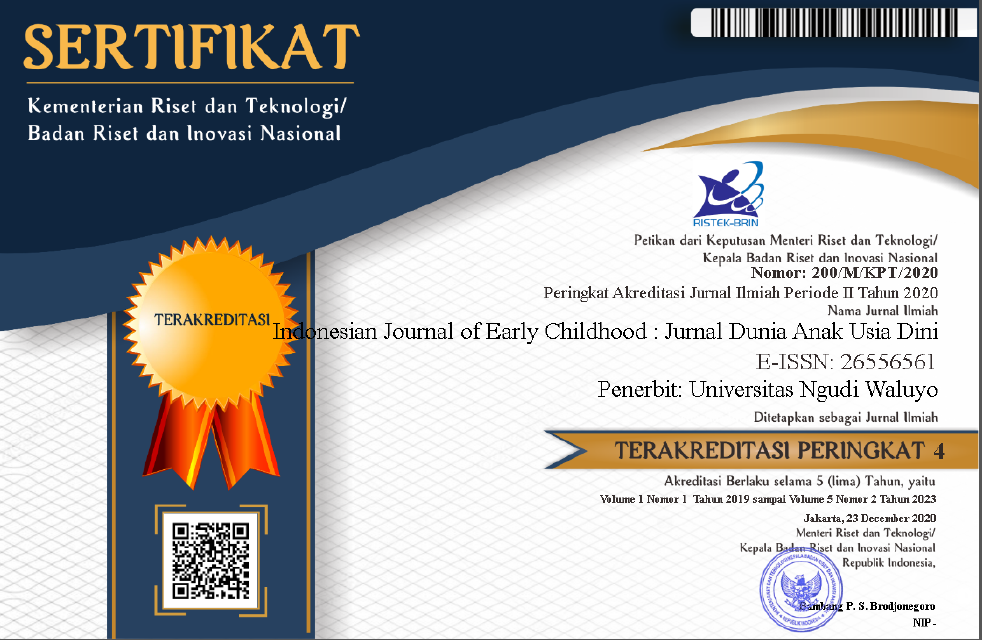Kesulitan Orang Tua dalam Identifikasi Awal Gejala Stunting
Parental Difficulties in Early Identification of Stunting Symptoms
DOI:
https://doi.org/10.35473/ijec.v7i1.2852Abstract
This study investigated the factors that make it difficult for parents to identify early symptoms of stunting in children aged 0-2 years. Findings showed significant associations between maternal occupation, immunisation and income and stunting status among under-fives, while access to health services and attitudes towards child health behaviours also played an important role. A systematic review of nutrition interventions confirmed the effectiveness of such programmes with an emphasis on cultural appropriateness. The identification of predisposing factors for stunting, such as gender, LBW and exclusive breastfeeding, provides useful insights for designing more specific interventions. The study also underscores the role of poor parenting in the incidence of stunting in early childhood, where factors such as education, knowledge, income, family size and parenting within the family play a central role. The conclusions of this study provide a strong basis for the development of more focused stunting prevention programmes, demonstrating the need for improved accessibility of health facilities, attention to policies supporting the health of working mothers, and a holistic approach to improving positive parenting.
ABSTRAK
Penelitian ini menyelidiki faktor-faktor yang menyulitkan orang tua dalam mengidentifikasi awal gejala stunting pada anak usia 0-2 tahun. Temuan menunjukkan adanya keterkaitan yang signifikan antara pekerjaan ibu, imunisasi, dan pendapatan dengan status stunting pada balita, sementara akses terhadap layanan kesehatan dan sikap terhadap perilaku kesehatan anak juga memiliki peran penting. Tinjauan sistematis terhadap intervensi gizi mengonfirmasi efektivitas program-program tersebut dengan penekanan pada penyesuaian budaya setempat. Identifikasi faktor predisposisi stunting, seperti jenis kelamin, BBLR, dan pemberian ASI eksklusif, memberikan wawasan yang berguna untuk merancang intervensi yang lebih spesifik. Penelitian juga menggarisbawahi peran pola asuh yang buruk dalam kejadian stunting pada anak usia dini, di mana faktor-faktor seperti pendidikan, pengetahuan, pendapatan, jumlah anggota keluarga, dan pola asuh dalam keluarga memainkan peran sentral. Simpulan dari penelitian ini memberikan dasar yang kuat untuk pengembangan program pencegahan stunting yang lebih terfokus, memperlihatkan perlunya peningkatan aksesibilitas fasilitas kesehatan, perhatian terhadap kebijakan mendukung kesehatan ibu bekerja, dan pendekatan holistik untuk meningkatkan pola asuh positif.
References
Abebe, Z., Haki, G. D., & Baye, K. (2016). Health extension workers’ knowledge and knowledge-sharing effectiveness of optimal infant and young child feeding are associated with mothers’ knowledge and child stunting in rural Ethiopia. Food and Nutrition Bulletin, 37, 353–363.
Abubakar, A., Holding, P., Van de Vijver, F. J. R., Newton, C., & Van Baar, A. (2010). Children at risk for developmental delay can be recognised by stunting, being underweight, ill health, little maternal schooling or high gravidity. Journal of Child Psychology and Psychiatry, 51, 652–659.
Akli, Z. (2015). Faktor-Faktor Yang Mempengaruhi Partisipasi Ibu Balita Dalam Mengikuti Kegiatan Posyandu (Studi Di Wilayah Puskesmas Sei Rahayu Kecamatan Teweh Tengah Kabupaten Barito Utara). STIE Indonesia Banjarmasin.
Apriluana, G., & Fikawati, S. (2018). Analisis faktor-faktor risiko terhadap kejadian stunting pada balita (0-59 bulan) di negara berkembang dan asia tenggara. Media Penelitian Dan Pengembangan Kesehatan, 28, 247–256.
Atamou, L., Rahmadiyah, D. C., Hassan, H., & Setiawan, A. (2023). Analysis of the Determinants of Stunting among Children Aged below Five Years in Stunting Locus Villages in Indonesia. Healthcare, 11, 810. MDPI.
Atmojo, J. T., Handayani, R. T., Darmayanti, A. T., Setyorini, C., & Widiyanto, A. (2020). Intervensi Gizi dalam Penanganan dan Pencegahan Stunting di Asia: Tinjauan Sistematis. (JKG) JURNAL KEPERAWATAN GLOBAL, 5, 26–30.
Beal, T., Tumilowicz, A., Sutrisna, A., Izwardy, D., & Neufeld, L. M. (2018). A review of child stunting determinants in Indonesia. Maternal & Child Nutrition, 14, e12617.
Bhutta, Z. A., Akseer, N., Keats, E. C., Vaivada, T., Baker, S., Horton, S. E., … Shekar, M. (2020). How countries can reduce child stunting at scale: lessons from exemplar countries. The American Journal of Clinical Nutrition, 112, 894S-904S.
Black, R. E. (2016). The legacy of the child health and nutrition research initiative (CHNRI). Journal of Global Health, 6.
Clark, H., Coll-Seck, A. M., Banerjee, A., Peterson, S., Dalglish, S. L., Ameratunga, S., … Borrazzo, J. (2020). A future for the world’s children? A WHO–UNICEF–Lancet Commission. The Lancet, 395, 605–658.
De Onis, M. (2017). Child growth and development. Nutrition and Health in a Developing World, 119–141.
De Onis, M., & Branca, F. (2016). Childhood stunting: a global perspective. Maternal & Child Nutrition, 12, 12–26.
Egghe, L., & Rousseau, R. (1990). Introduction to informetrics. Quantitative methods in library, documentation and information science. Elsevier Science Publishers.
Fawzi, M. C. S., Andrews, K. G., Fink, G., Danaei, G., McCoy, D. C., Sudfeld, C. R., … Finlay, J. E. (2019). Lifetime economic impact of the burden of childhood stunting attributable to maternal psychosocial risk factors in 137 low/middle-income countries. BMJ Global Health, 4, e001144.
Haines, A. C., Jones, A. C., Kriser, H., Dunn, E. L., Graff, T., Bennett, C., … Torres, S. (2018). Analysis Of Rural Indonesian Mothers’ Knowledge, Attitudes, And Beliefs Regarding Stunting. Medical Research Archives, 6.
Hamer, W., Maliki, B. B., & Mapruhah, A. (2022). Meningkatkan Kesadaran Masyarakat akan Pentingnya Pemenuhan Gizi dalam mencegah stunting di Desa Sukamaju Kecamatan Labuan Kabupaten Pandeglang. Jurnal Penyuluhan Dan Pemberdayaan Masyarakat, 1, 14–20.
Handayani, T. P., Wahyuni, T., Syswianti, D., Suazini, E. R., Humaeroh, L., & Alvia, R. (2022). EDUKASI PADA ORANG TUA DAN DETEKSI DINI STUNTING PADA ANAK USIA PRA SEKOLAH TPQ AR ROZA KECAMATAN GARUT KOTA KABUPATEN GARUT. Jurnal Pengabdian Masyarakat DEDIKASI, 3, 99–105.
Islami, N. W., & Khouroh, U. (2021). Analisis faktor-faktor yang mempengaruhi balita stunting dan tantangan pencegahannya pada masa pandemi. KARTA RAHARDJA: Jurnal Pembangunan Dan Inovasi, 3, 6–19.
Mahmood, L., Flores-Barrantes, P., Moreno, L. A., Manios, Y., & Gonzalez-Gil, E. M. (2021). The influence of parental dietary behaviors and practices on children’s eating habits. Nutrients, 13, 1138.
Manggala, A. K., Kenwa, K. W. M., Kenwa, M. M. L., Jaya, A. A. G. D. P., & Sawitri, A. A. S. (2018). Risk factors of stunting in children aged 24-59 months. Paediatrica Indonesiana, 58, 205–212.
Martony, O. (2023). Stunting di Indonesia: Tantangan dan Solusi di Era Modern. Journal of Telenursing (JOTING), 5, 1734–1745.
Novitasari, R., & Rosita, E. (2022). REFRESH UPAYA PENCEGAHAN STUNTING PADA BAYI DENGAN PELATIHAN KONSELING PEMBERIAN ASI EKSKLUSIF DI DINAS KESEHATAN JOMBANG TAHUN 2022. Jurnal Pengabdian Masyarakat Kebidanan, 4, 21–28.
Nurhalizah, N., Salama, N., & Hajeni, H. (2023). Pola asuh orang tua dengan kejadian stunting pada anak usia dini. Pola Asuh Orang Tua Dengan Kejadian Stunting Pada Anak Usia Dini, 9, 86–95.
Pelletier, D., Haider, R., Hajeebhoy, N., Mangasaryan, N., Mwadime, R., & Sarkar, S. (2013). The principles and practices of nutrition advocacy: evidence, experience and the way forward for stunting reduction. Maternal & Child Nutrition, 9, 83–100.
Ramirez-Rubio, O., Daher, C., Fanjul, G., Gascon, M., Mueller, N., Pajín, L., … Nieuwenhuijsen, M. J. (2019). Urban health: an example of a “health in all policies” approach in the context of SDGs implementation. Globalization and Health, 15, 1–21.
Rokx, C., Subandoro, A., & Gallagher, P. (2018). Aiming high: Indonesia’s ambition to reduce stunting.
Scheffler, C., & Hermanussen, M. (2022). Stunting is the natural condition of human height. American Journal of Human Biology, 34, e23693.
Tett, L. (2001). Parents as problems or parents as people? Parental involvement programmes, schools and adult educators. International Journal of Lifelong Education, 20, 188–198.
Tette, E. M. A., Sifah, E. K., & Nartey, E. T. (2015). Factors affecting malnutrition in children and the uptake of interventions to prevent the condition. BMC Pediatrics, 15, 1–11.
Togia, A., & Malliari, A. (2017). Research Methods in Library and Information Science. In Qualitative versus Quantitative Research. InTech.
Widyaningsih, C. A., Didah, D., Sari, P., Wijaya, M., & Rinawan, F. R. (2021). Identifikasi faktor-faktor kejadian stunting. Jurnal Kebidanan Malahayati, 7, 207–214.
Woldehanna, T., Behrman, J. R., & Araya, M. W. (2017). The effect of early childhood stunting on children’s cognitive achievements: Evidence from young lives Ethiopia. Ethiopian Journal of Health Development, 31, 75–84.
Downloads
Published
How to Cite
Issue
Section
License
Copyright (c) 2025 Indonesian Journal of Early Childhood: Jurnal Dunia Anak Usia Dini

This work is licensed under a Creative Commons Attribution-ShareAlike 4.0 International License.
Please find the rights and licenses in Indonesian Journal Of Early Childhood: Jurnal Dunia Anak Usia DIni. By submitting the article/manuscript of the article, the author(s) agree with this policy. No specific document sign-off is required.
1. License
The non-commercial use of the article will be governed by the Creative Commons Attribution license as currently displayed on Creative Commons Attribution-ShareAlike 4.0 International License.
2. Author(s)' Warranties
The author warrants that the article is original, written by stated author(s), has not been published before, contains no unlawful statements, does not infringe the rights of others, is subject to copyright that is vested exclusively in the author and free of any third party rights, and that any necessary written permissions to quote from other sources have been obtained by the author(s).
3. User Rights
Indonesian Journal Of Early Childhood: Jurnal Dunia Anak Usia Dini's spirit is to disseminate articles published are as free as possible. Under the Creative Commons license, Indonesian Journal Of Early Childhood: Jurnal Dunia Anak Usia Dini permits users to copy, distribute, display, and perform the work for non-commercial purposes only. Users will also need to attribute authors and Indonesian Journal Of Early Childhood: Jurnal Dunia Anak Usia Dini on distributing works in the journal and other media of publications.
4. Co-Authorship
If the article was jointly prepared by more than one author, any authors submitting the manuscript warrants that he/she has been authorized by all co-authors to be agreed on this copyright and license notice (agreement) on their behalf, and agrees to inform his/her co-authors of the terms of this policy. Indonesian Journal Of Early Childhood: Jurnal Dunia Anak Usia Dini will not be held liable for anything that may arise due to the author(s) internal dispute. Indonesian Journal Of Early Childhood: Jurnal Dunia Anak Usia Dini will only communicate with the corresponding author.
5. Miscellaneous
Indonesian Journal Of Early Childhood: Jurnal Dunia Anak Usia Dini will publish the article (or have it published) in the journal if the article’s editorial process is successfully completed. Indonesian Journal Of Early Childhood: Jurnal Dunia Anak Usia Dini's editors may modify the article to a style of punctuation, spelling, capitalization, referencing and usage that deems appropriate. The author acknowledges that the article may be published so that it will be publicly accessible and such access will be free of charge for the readers as mentioned in point 3.
Â
Every accepted manuscript should be accompanied by "Copyright Transfer Agreement" prior to the article publication.



